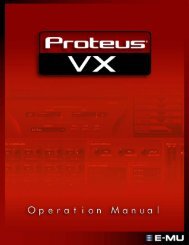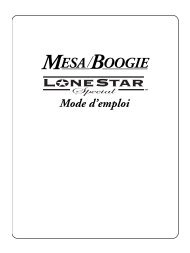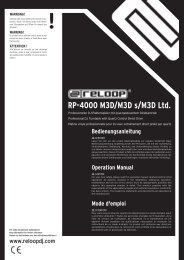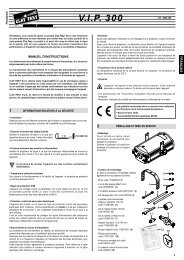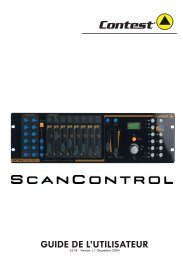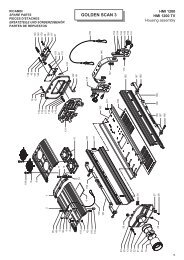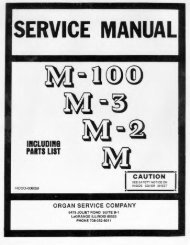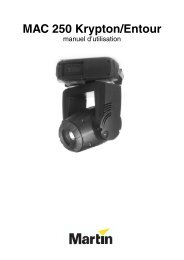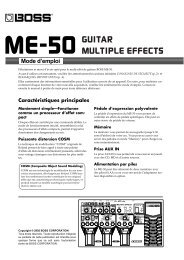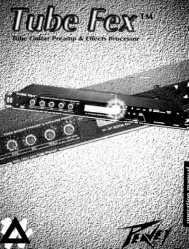Sequential Circuits Prophet-5 Service Manual - Audiofanzine
Sequential Circuits Prophet-5 Service Manual - Audiofanzine
Sequential Circuits Prophet-5 Service Manual - Audiofanzine
Create successful ePaper yourself
Turn your PDF publications into a flip-book with our unique Google optimized e-Paper software.
'1^iAbout This <strong>Manual</strong> and Servicing The <strong>Prophet</strong>The <strong>Prophet</strong> is a sophisticated instrument and SCI issues its technical manual for use by qualifiedtechnicians only. Of course the manual will be read by <strong>Prophet</strong> owners and others interested insynthesizer design. And we realize it will also be used by some to develop modifications for theinstrument. While we support this innovative attitude in spirit, we cannot support it financially:Modifications or unauthorized service void the <strong>Prophet</strong>'s warranty. They also invariably extend servicetime (thus, cost) if factory repair is required. Familiarize yourself thoroughly with this manual beforeattempting any work on the <strong>Prophet</strong>. This will at least help you judge whether you should be workingon it at all. If in doubt, please contact our <strong>Service</strong> Department.This edition of the Technical <strong>Manual</strong> (TM1000D) documents <strong>Prophet</strong>-5s with serialnumbers 1301 andabove. Although great care was taken to ensure the changes would be transparent to players,predecessors. Rev 2 (S/N 184-1299, seetechnicians will find "Rev 3" quite a different instrument from itsTM1000C) was a mere refinement of Rev 1 (S/N 1-182). Rev 3, however, uses new voltage-controlled ICsin the analog synthesizer and, in the microcomputer, a vastly different ADC, DAC and control voltagedistribution scheme. Although the main purpose of the revision was to remove production limitationscaused by inconsistent supply and quality of the previous synth *'chip set/' the hardware redesignencouraged the implementation of more sophisticated editing, tuning and maintenance software whileimproving servicabiiity; the number of voice trimmers being reduced from 80 to 45.The manual is organized as follows:SECTION 1, MECHANICAL provides a physical introduction and directions fordisassembling/assembling the <strong>Prophet</strong>.SECTION 2, THEORY explains general function and circuit operation, referring to block diagrams and tothe schematics for hardware details.SECTION 3, DOCUMENTS contains schematics and pictorials identifying all components.SECTION 4, SERVICE contains procedures for routine tests and trims.SECTION 5, PARTS cross-references component designators to SCI stock numbers.SECTION 6, GLOSSARY decodes abbreviations appearing on SCI documentation.SECTION 7, APPENDIX contains selected data sheets.Your response to the questionnaire on the next page will help us monitor our publication's usefulnessAbout The Second EditionIn addition, to the original revision 3.0 data (with a few corrections), the followingmaterial covering later refinements of the instrument has been added. The revisionsoccured chiefly in the microcomputer's memory configuration, added PITCH and MODCV inputs, and in the addition of a serial interface for communication with the Model1005 Polyphonic Sequencer or Model 1001 Remote Keyboard.SECTION if THEORY discusses the hardware changes comprising revisions 3.1 and 3.2.SECTION 9, PROGRAMMING covers use of the serial interface.mSECTION 10, DOCUMENTS contains schematics and pictorials for revisions 3.1 and 3.2.SECTION 11, SERVICE includes instructions for updating a 3.0 or 3.1 instrument tolevel 3.2, for using the diagnostic memory tests, and for an added adjustment onPCB 3.SECTION 12, PARTS lists SCI stock numbers for 3.1 and 3.2-Ievel assemblies.D.2



